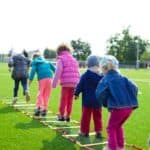
Re-post: Childhood sedentariness causes excessive insulin, raising the risk of type 2 diabetes
May 2, 2024
Physical activity, sedentary behaviour, and sleep knowledge and self-efficacy among parents of young children in Canada
May 22, 2024A new study entitled, “The impact of the world’s first regulatory, multi-setting intervention on sedentary behaviour among children and adolescents (ENERGISE): a natural experiment evaluation” was published in International Journal of Behavioral Nutrition and Physical Activity. A summary and citation are included below.
ABSTRACT
Background
Regulatory actions are increasingly used to tackle issues such as excessive alcohol or sugar intake, but such actions to reduce sedentary behaviour remain scarce. World Health Organization (WHO) guidelines on sedentary behaviour call for system-wide policies. The Chinese government introduced the world’s first nation-wide multi-setting regulation on multiple types of sedentary behaviour in children and adolescents in July 2021. This regulation restricts when (and for how long) online gaming businesses can provide access to pupils; the amount of homework teachers can assign to pupils according to their year groups; and when tutoring businesses can provide lessons to pupils. We evaluated the effect of this regulation on sedentary behaviour safeguarding pupils.Methods
With a natural experiment evaluation design, we used representative surveillance data from 9- to 18-year-old pupils before and after the introduction of the regulation, for longitudinal (n = 7,054, matched individuals, primary analysis) and repeated cross-sectional (n = 99,947, exploratory analysis) analyses. We analysed pre-post differences for self-reported sedentary behaviour outcomes (total sedentary behaviour time, screen viewing time, electronic device use time, homework time, and out-of-campus learning time) using multilevel models, and explored differences by sex, education stage, residency, and baseline weight status.Results
Longitudinal analyses indicated that pupils had reduced their mean total daily sedentary behaviour time by 13.8% (95% confidence interval [CI]: -15.9 to -11.7%, approximately 46 min) and were 1.20 times as likely to meet international daily screen time recommendations (95% CI: 1.01 to 1.32) one month after the introduction of the regulation compared to the reference group (before its introduction). They were on average 2.79 times as likely to meet the regulatory requirement on homework time (95% CI: 2.47 to 3.14) than the reference group and reduced their daily total screen-viewing time by 6.4% (95% CI: -9.6 to -3.3%, approximately 10 min). The positive effects were more pronounced among high-risk groups (secondary school and urban pupils who generally spend more time in sedentary behaviour) than in low-risk groups (primary school and rural pupils who generally spend less time in sedentary behaviour). The exploratory analyses showed comparable findings.Conclusions
This regulatory intervention has been effective in reducing total and specific types of sedentary behaviour among Chinese children and adolescents, with the potential to reduce health inequalities. International researchers and policy makers may explore the feasibility and acceptability of implementing regulatory interventions on sedentary behaviour elsewhere.
CITATION
Li, B., Valerino-Perea, S., Zhou, W., Xie, Y., Syrett, K., Peters, R., He, Z., Zou, Y., de Vocht, F., & Foster, C. (2024). The impact of the world’s first regulatory, multi-setting intervention on sedentary behaviour among children and adolescents (ENERGISE): a natural experiment evaluation. International Journal of Behavioral Nutrition and Physical Activity, 21(53), 1-12. https://doi.org/10.1186/s12966-024-01591-w
Photo by Norma Mortenson on pexels




